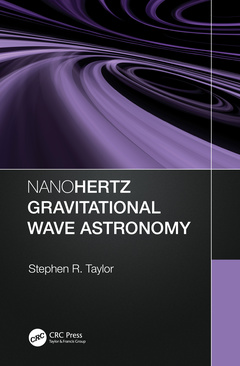Nanohertz Gravitational Wave Astronomy
Auteur : Taylor Stephen R.

Nanohertz Gravitational Wave Astronomy explores the exciting hunt for low frequency gravitational waves by using the extraordinary timing precision of pulsars. The book takes the reader on a tour across the expansive gravitational-wave landscape, from LIGO detections to the search for polarization patterns in the Cosmic Microwave Background, then hones in on the band of nanohertz frequencies that Pulsar Timing Arrays (PTAs) are sensitive to. Within this band may lie many pairs of the most massive black holes in the entire Universe, all radiating in chorus to produce a background of gravitational waves. The book shows how such extra-Galactic gravitational waves can alter the arrival times of radio pulses emanating from monitored Galactic pulsars, and how we can use the pattern of correlated timing deviations from many pulsars to tease out the elusive signal.
The book takes a pragmatic approach to data analysis, explaining how it is performed in practice within classical and Bayesian statistics, as well as the numerous strategies one can use to optimize numerical Bayesian searches in PTA analyses. It closes with a complete discussion of the data model for nanohertz gravitational wave searches, and an overview of the past achievements, present efforts, and future prospects for PTAs.
The book is accessible to upper division undergraduate students and graduate students of astronomy, and also serves as a useful desk reference for experts in the field.
Key features:
- Contains a complete derivation of the pulsar timing response to gravitational waves, and the overlap reduction function for PTAs.
- Presents a comprehensive overview of source astrophysics, and the dynamical influences that shape the gravitational wave signals that PTAs are sensitive to.
- Serves as a detailed primer on gravitational-wave data analysis and numerical Bayesian techniques for PTAs.
1. A Window onto the Warped Universe. 2. Gravity and Gravitational Waves. 3. Pulsar Timing. 4. Sources and Signals. 5. Data Analysis. 6. Numerical Bayesian Techniques. 7. The PTA Likelihood. 8. The Past, Present and Future of PTA's
Stephen R. Taylor is an Assistant Professor of Physics & Astronomy at Vanderbilt University in Nashville, Tennessee. Born and raised in Lisburn, Northern Ireland, he went on to read Physics at Jesus College, Oxford from 2006-2010, and earned his PhD from the Institute of Astronomy at the University of Cambridge in 2014. His positions have included a NASA Postdoctoral Fellowship at NASA's Jet Propulsion Laboratory, and a NANOGrav Senior Postdoctoral Fellowship at the California Institute of Technology in Pasadena, California. He currently lives in Nashville with his wife Erika and cat Olive.
Date de parution : 11-2021
15.6x23.4 cm
Date de parution : 11-2021
15.6x23.4 cm
Thèmes de Nanohertz Gravitational Wave Astronomy :
Mots-clés :
PTAs; Pulsar Timing Arrays; classical and Bayesian statistics; pulsars; black holes; gravitational waves; interstellar medium; ISM; background radiation; cosmic microwave; CMB; Bayesian Evidence; Radiometer Noise; Energy Density; Posterior Distribution; Neutron Stars; GW Signal; Cross-power Spectral Density; CMB; Cosmic Microwave Background; Fractional Energy Density; Metropolis Hastings Ratio; Target Posterior Distribution; AM; Cosmic Strings; Savage Dickey Density Ratio; Millisecond Pulsars; Pulse Arrival; MCMC Iteration; Proposal Distribution; Dark Matter; Posterior Predictive Density; Autocorrelation Length; Induced Timing Delays; Parameter Covariance Matrix



